![[Live from Earth and Mars]](http://www-k12.atmos.washington.edu/k12/graphics/xmars_map.gif.pagespeed.ic.Bwqa4QZhmw.png)

![[Live from Earth and Mars]](http://www-k12.atmos.washington.edu/k12/graphics/xmars_map.gif.pagespeed.ic.Bwqa4QZhmw.png)

Camera 1 image (Frame 21H031/595) and Camera 2 image (22H030/595) of Lander 2 show the surface sampler arm after the sample collector head was pushed into soillike material during a "surface bearing test." The images are high-resolution images. Sol 595 corresponds to March 23, 1978 on Earth. The thin and thick black lines are caused by data losses. The surface and test can be viewed in 3-D or stereo.
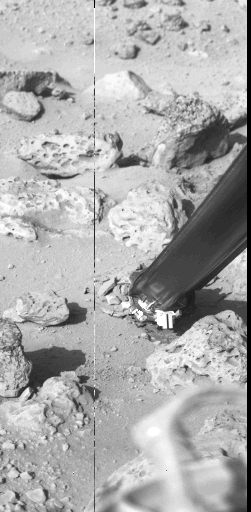
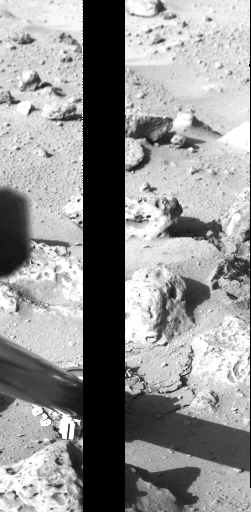
Camera 1 image (Frame 21H034/595) and Camera 2 image (22H033/595) of Lander 2 show the trench that was produced after the collector head was removed from the soillike material. The two images form a high-resolution stereo-pair.
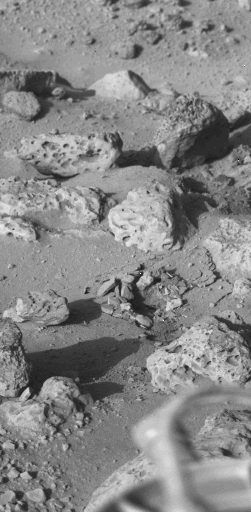
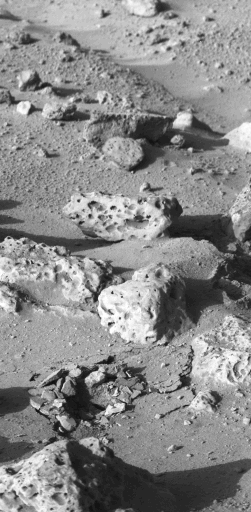
The trench is about 7 or 8 cm wide from rim to rim.
Note the tabular clods and extensive deformation of the surface around the trench which can also be seen in the previous images. Changes can also be determined by comparing Frames 22H014/594 (taken before the test) and 22H033/595 (taken after the test). Viewing one frame with one eye and the other frame with the other eye will allow you to detect subtle changes.
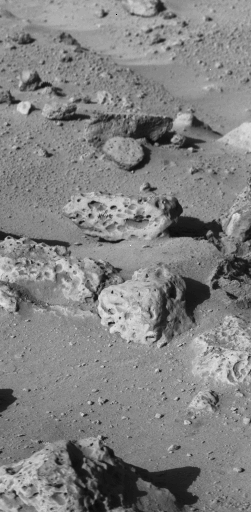

You can view the surface and trench in 3-D because images of the same scene taken by Viking lander Camera 1 and Camera 2 under similar lighting conditions will form a stereoscopic pair of images.
If you view the left image with the left eye and the right image with the right eye, you can see this small area and trench in 3-D! 3-D viewing is easier to achieve in the top parts of the images with a stereoscope. (View a print as any hard object can damage the coating on the screen.) Note how the soil broke into clods.
Here is the stereo pair with 21H034/595 on the left, rotated 2.5 degrees clockwise, and 22H033/595 on the right rotated 2.5 degrees counterclockwise. The images have been cropped and aligned. Viewing them with the unaided eye is easiest when the same small object shown in both images is about 4.5 cm apart.
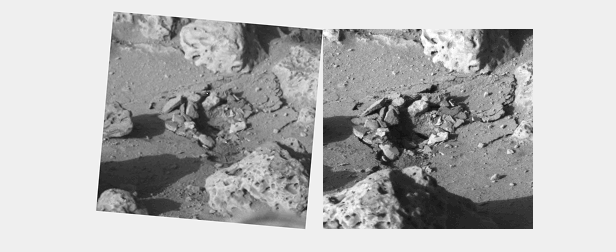
The arm of the sampler and the collector head were inclined about 40 degrees from the horizontal during the test.
The axial force on the collector head rose to about 50 pounds (about 222N) and then the sampler motor stalled.
The face of the collector head is about 5 cm by 5 cm and its lower edge penetrated to about 8 cm below the surface. Assume that the face of the collector head was perpendicular to the axis of the arm during the test.
What do you think this soillike material at the Lander 2 site is like?
| The data, maps, and text for this exercise were supplied by: Dr. Henry John Moore Scientist Emeritus Astrogeology Team MS 975 U.S. Geological Survey 345 Middlefield Road Menlo Park, CA 94025 moore@astmnl.wr.usgs.gov |
The images, layout, and presentation for this exercise were supplied by; James E. Tillman, Research Prof. (mars@atmos.washington.edu ) and George F. LeCompte (a volunteer) Department of Atmospheric Sciences PO Box 351640 University of Washington Seattle, WA 98195-1640 |
